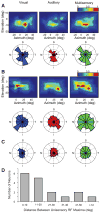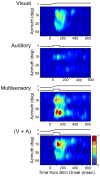Spatial heterogeneity of cortical receptive fields and its impact on multisensory interactions
- PMID: 18287544
- PMCID: PMC3637795
- DOI: 10.1152/jn.01386.2007
Spatial heterogeneity of cortical receptive fields and its impact on multisensory interactions
Abstract
Investigations of multisensory processing at the level of the single neuron have illustrated the importance of the spatial and temporal relationship of the paired stimuli and their relative effectiveness in determining the product of the resultant interaction. Although these principles provide a good first-order description of the interactive process, they were derived by treating space, time, and effectiveness as independent factors. In the anterior ectosylvian sulcus (AES) of the cat, previous work hinted that the spatial receptive field (SRF) architecture of multisensory neurons might play an important role in multisensory processing due to differences in the vigor of responses to identical stimuli placed at different locations within the SRF. In this study the impact of SRF architecture on cortical multisensory processing was investigated using semichronic single-unit electrophysiological experiments targeting a multisensory domain of the cat AES. The visual and auditory SRFs of AES multisensory neurons exhibited striking response heterogeneity, with SRF architecture appearing to play a major role in the multisensory interactions. The deterministic role of SRF architecture was tightly coupled to the manner in which stimulus location modulated the responsiveness of the neuron. Thus multisensory stimulus combinations at weakly effective locations within the SRF resulted in large (often superadditive) response enhancements, whereas combinations at more effective spatial locations resulted in smaller (additive/subadditive) interactions. These results provide important insights into the spatial organization and processing capabilities of cortical multisensory neurons, features that may provide important clues as to the functional roles played by this area in spatially directed perceptual processes.
Figures







Similar articles
-
Spatiotemporal architecture of cortical receptive fields and its impact on multisensory interactions.Exp Brain Res. 2009 Sep;198(2-3):127-36. doi: 10.1007/s00221-009-1772-y. Epub 2009 Mar 24. Exp Brain Res. 2009. PMID: 19308362 Free PMC article.
-
Spatial receptive field organization of multisensory neurons and its impact on multisensory interactions.Hear Res. 2009 Dec;258(1-2):47-54. doi: 10.1016/j.heares.2009.08.003. Epub 2009 Aug 19. Hear Res. 2009. PMID: 19698773 Free PMC article. Review.
-
Heterogeneity in the spatial receptive field architecture of multisensory neurons of the superior colliculus and its effects on multisensory integration.Neuroscience. 2014 Jan 3;256:147-62. doi: 10.1016/j.neuroscience.2013.10.044. Epub 2013 Oct 30. Neuroscience. 2014. PMID: 24183964 Free PMC article.
-
Spatial determinants of multisensory integration in cat superior colliculus neurons.J Neurophysiol. 1996 May;75(5):1843-57. doi: 10.1152/jn.1996.75.5.1843. J Neurophysiol. 1996. PMID: 8734584
-
Neural mechanisms for synthesizing sensory information and producing adaptive behaviors.Exp Brain Res. 1998 Nov;123(1-2):124-35. doi: 10.1007/s002210050553. Exp Brain Res. 1998. PMID: 9835401 Review.
Cited by
-
Individual Differences in Multisensory Interactions:The Influence of Temporal Phase Coherence and Auditory Salience on Visual Contrast Sensitivity.Vision (Basel). 2020 Feb 5;4(1):12. doi: 10.3390/vision4010012. Vision (Basel). 2020. PMID: 32033350 Free PMC article.
-
Interactions between space and effectiveness in human multisensory performance.Neuropsychologia. 2016 Jul 29;88:83-91. doi: 10.1016/j.neuropsychologia.2016.01.031. Epub 2016 Jan 27. Neuropsychologia. 2016. PMID: 26826522 Free PMC article.
-
Cross-Modal Plasticity in Higher-Order Auditory Cortex of Congenitally Deaf Cats Does Not Limit Auditory Responsiveness to Cochlear Implants.J Neurosci. 2016 Jun 8;36(23):6175-85. doi: 10.1523/JNEUROSCI.0046-16.2016. J Neurosci. 2016. PMID: 27277796 Free PMC article.
-
Spatiotemporal architecture of cortical receptive fields and its impact on multisensory interactions.Exp Brain Res. 2009 Sep;198(2-3):127-36. doi: 10.1007/s00221-009-1772-y. Epub 2009 Mar 24. Exp Brain Res. 2009. PMID: 19308362 Free PMC article.
-
Spatial receptive field organization of multisensory neurons and its impact on multisensory interactions.Hear Res. 2009 Dec;258(1-2):47-54. doi: 10.1016/j.heares.2009.08.003. Epub 2009 Aug 19. Hear Res. 2009. PMID: 19698773 Free PMC article. Review.
References
-
- Anastasio TJ, Patton PE, Belkacem-Boussaid K. Using Bayes’ rule to model multisensory enhancement in the superior colliculus. Neural Comput. 2000;12:1165–1187. - PubMed
-
- Avillac M, Deneve S, Olivier E, Pouget A, Duhamel JR. Reference frames for representing visual and tactile locations in parietal cortex. Nat Neurosci. 2005;8:941–949. - PubMed
-
- Barraclough NE, Xiao D, Baker CI, Oram MW, Perrett DI. Integration of visual and auditory information by superior temporal sulcus neurons responsive to the sight of actions. J Cogn Neurosci. 2005;17:377–391. - PubMed
-
- Beauchamp MS, Argall BD, Bodurka J, Duyn JH, Martin A. Unraveling multisensory integration: patchy organization within human STS multisensory cortex. Nat Neurosci. 2004;7:1190–1192. - PubMed
Publication types
MeSH terms
Grants and funding
LinkOut - more resources
Full Text Sources
Miscellaneous

